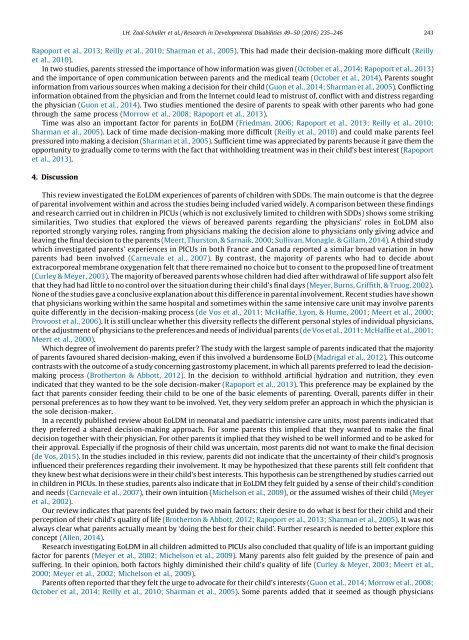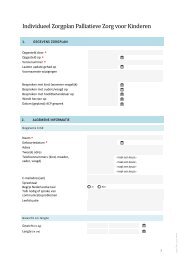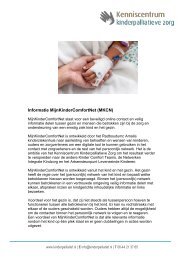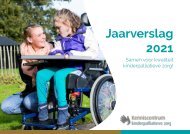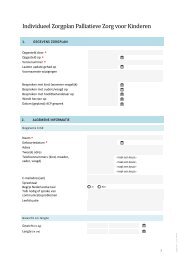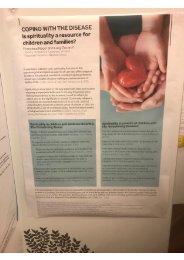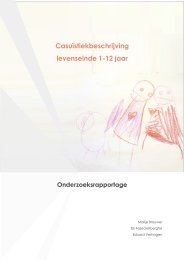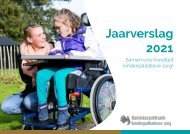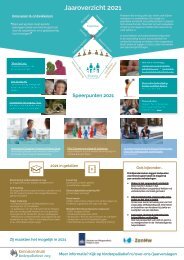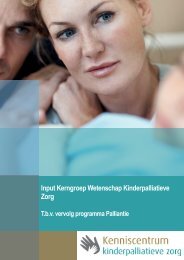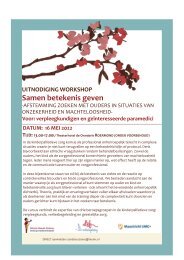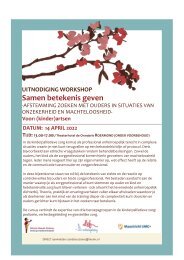End-of-life decision-making for children with severe developmental disabilities
Create successful ePaper yourself
Turn your PDF publications into a flip-book with our unique Google optimized e-Paper software.
I.H. Zaal-Schuller et al. / Research in Developmental Disabilities 49–50 (2016) 235–246 241<br />
Table 2<br />
Guidelines in EoLDM in each involved country.<br />
United Kingdom—Consent to the <strong>with</strong>holding or <strong>with</strong>drawal <strong>of</strong> treatment may be given by anyone who holds parental responsibility. However, if there<br />
is parental opposition or a disagreement as to what is in the child’s or young person’s best interests, an application should be made to court <strong>for</strong> a<br />
determination as to best interests. The High Court has overarching authority in <strong>decision</strong>s about <strong>children</strong>. When individuals ask <strong>for</strong> treatment that the<br />
health care pr<strong>of</strong>essional has not <strong>of</strong>fered and which he or she considers not clinically appropriate <strong>for</strong> the patient, the pr<strong>of</strong>essional is not obliged to<br />
provide it a<br />
United States—The <strong>decision</strong> to <strong>with</strong>hold or discontinue health care may be considered by providers in conjunction <strong>with</strong> the parents acting in the best<br />
interests <strong>of</strong> the child b . In the small number <strong>of</strong> cases where agreement is not possible, physicians are not obligated to <strong>of</strong>fer therapies that they believe<br />
cannot achieve the goals <strong>of</strong> care. A process-based approach is recommended to resolve conflicts over end-<strong>of</strong>-<strong>life</strong> issues. Central to this process is<br />
mediation by the hospital ethics committee c . If the ethics consultation process fails to resolve the dispute, the hospital must try to arrange transfer <strong>of</strong><br />
the patient to another physician or institute willing to give the treatment requested by the family. If no such provider can be found, the hospital and<br />
physician may unilaterally <strong>with</strong>hold or <strong>with</strong>draw therapy that has been determined to be futile d<br />
Canada—Physicians are not obliged to provide treatments that would not be <strong>of</strong> benefit to the patient; however, unilateral physician <strong>decision</strong>-<strong>making</strong> is<br />
not endorsed. If the substitute <strong>decision</strong>-makers insist on a course <strong>of</strong> treatment that the physician considers medically inappropriate, the physicianis<br />
obliged to assist in finding a treatment team that will agree to treat according to the consent given. When all mediation attempts have failed, the<br />
physician may apply to a judicial body to challenge the substitute <strong>decision</strong>-makers’ <strong>decision</strong>. This option should be considered only after alternative<br />
methods <strong>of</strong> conflict resolution have been exhausted e<br />
Australia—The senior treating clinician should not merely outline treatment options then delegate <strong>decision</strong>-<strong>making</strong> responsibility to families, but<br />
rather they should make recommendations <strong>for</strong> management based on their understanding <strong>of</strong> the patient’s medical condition and prognosis, while<br />
continuing to work <strong>with</strong>, and support, a family and reach a consensus <strong>decision</strong>. Where the process fails to bring a consensus about the appropriateness<br />
<strong>of</strong> treatment limitation, resolution will require application to the Court f<br />
a Larcher, V., Craig, F., Bhogal, K., Wilkinson, D., Brierley, J., Royal College <strong>of</strong>, P., & Child, H. (2015). Making <strong>decision</strong>s to limit treatment in <strong>life</strong>-limiting and<br />
<strong>life</strong>-threatening conditions in <strong>children</strong>: A framework <strong>for</strong> practice. Archives <strong>of</strong> Disease in Childhood, 100 Suppl 2, s3-23.<br />
b Eden, L. M., & Callister, L. C. (2010). Parent Involvement in <strong>End</strong>-<strong>of</strong>-Life Care and Decision Making in the Newborn Intensive Care Unit: An Integrative<br />
Review. Journal <strong>of</strong> Perinatal Education, 19, 29-39.<br />
c Truog, R. D., Campbell, M. L., Curtis, J. R., Haas, C. E., Luce, J. M., & Rubenfeld, G. D., et al. & American Academy <strong>of</strong> Critical Care, M. (2008).<br />
Recommendations <strong>for</strong> end-<strong>of</strong>-<strong>life</strong> care in the intensive care unit: A consensus statement by the American College <strong>of</strong> Critical Care Medicine. Critical Care<br />
Medicine, 36, 953–963.<br />
d Fine, R. L., & Mayo, T. W. (2003). Resolution <strong>of</strong> futility by due process: Early experience <strong>with</strong> the Texas Advance Directives Act. Annals <strong>of</strong> Internal Medicine,<br />
138, 743-746<br />
e Choong, K., Cupido, C., Nelson, E., Arnold, D. M., Burns, K., & Cook, D., et al. & Accademy. (2010). A framework <strong>for</strong> resolving disagreement during end <strong>of</strong> <strong>life</strong><br />
care in the critical care unit. Clinical & Investigative Medicine, 33, E240-253.<br />
f<br />
Office <strong>of</strong> the Chief Health Officer (2012). Guidelines <strong>for</strong> end-<strong>of</strong> <strong>life</strong> care and <strong>decision</strong>-<strong>making</strong> (pp. 1–17). Sydney: NSW Department <strong>of</strong> Health.<br />
3.1. Involvement experienced by parents<br />
Four studies investigated how parents experienced their involvement in the EoLDM process (Brotherton & Abbott, 2012;<br />
Morrow et al., 2008; Reilly et al., 2010; Sharman et al., 2005). The degree <strong>of</strong> involvement ranged from parents being the sole<br />
<strong>decision</strong>-maker to the physician being the sole <strong>decision</strong>-maker. The latter cases were described in more detail, and parents<br />
indicated that the experience <strong>of</strong> not being included caused negative emotions (Brotherton & Abbott, 2012; Morrow et al.,<br />
2008; Sharman et al., 2005).<br />
Two qualitative studies described the experiences <strong>of</strong> parents who faced the <strong>decision</strong> about a gastrostomy placement to<br />
achieve adequate nutritional intake <strong>for</strong> their child (Brotherton & Abbott, 2012; Morrow et al., 2008). In the first study, some<br />
mothers identified their physician as the sole <strong>decision</strong>-maker while several other mothers described themselves as such,<br />
even though, from a clinical perspective, they all appeared to be in the same situation: all <strong>of</strong> their <strong>children</strong> required enteral<br />
tube feeding to achieve adequate nutritional intake (Brotherton & Abbott, 2012). These difference in experienced<br />
involvement could be explained by the fact that in this study only the personal perspective <strong>of</strong> how much choice they received<br />
from the physician was described. In the second study, which included parents <strong>of</strong> <strong>children</strong> <strong>with</strong> cerebral palsy, parents <strong>of</strong>ten<br />
indicated that they felt their opinion was not considered important. Moreover, some parents indicated that they felt<br />
pressured to accept the gastrostomy. They believed they were made to feel guilty or ashamed, particularly <strong>with</strong> regard to<br />
their child’s nutritional status (Morrow et al., 2008). A similar feeling <strong>of</strong> pressure was described by some parents who felt<br />
they had to accept an EoLD (Sharman et al., 2005).<br />
In a study by Reilly et al. (2010), six couples who had lost a child <strong>with</strong> Down syndrome and a congenital heart condition<br />
were interviewed. All couples mentioned that they had felt highly involved in their child’s care and in <strong>decision</strong>s regarding<br />
their child’s medical treatment, but they did not specify the extent to which they had been involved in the EoLDM <strong>for</strong> their<br />
child.<br />
3.2. Involvement preferred by parents<br />
The way in which parents preferred to be involved varied widely and seemed to be highly influenced by the type <strong>of</strong><br />
<strong>decision</strong>s. One study investigated whether parents’ preferences regarding EoLDM <strong>for</strong> their child were influenced by the<br />
child’s disease characteristics. Child’s disease characteristics, such as diagnosis, the presence <strong>of</strong> chronic conditions or<br />
previous hospital admissions, were not significantly associated <strong>with</strong> parents’ <strong>decision</strong>-<strong>making</strong> preferences (Madrigal et al.,<br />
2012). Most parents included in this study preferred shared <strong>decision</strong>-<strong>making</strong> <strong>with</strong> their physician (40%) or (largely) <strong>making</strong><br />
the final <strong>decision</strong> on their own (41%). A still-sizeable minority <strong>of</strong> 19% preferred the physician to be the sole <strong>decision</strong>-maker.


